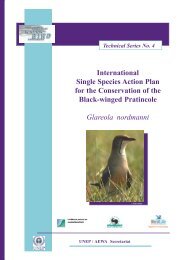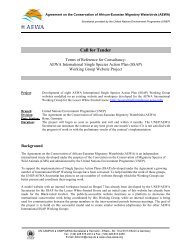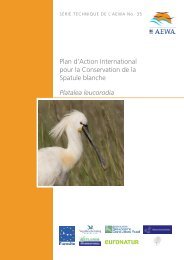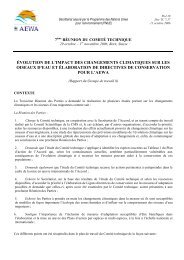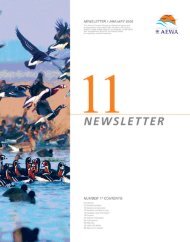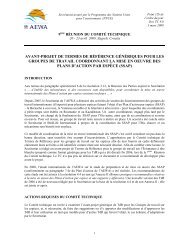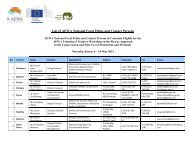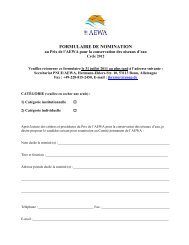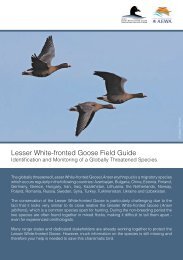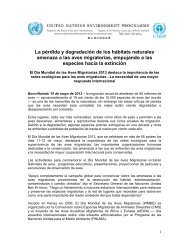International Single Species Action Plan for the ... - AEWA
International Single Species Action Plan for the ... - AEWA
International Single Species Action Plan for the ... - AEWA
Create successful ePaper yourself
Turn your PDF publications into a flip-book with our unique Google optimized e-Paper software.
<strong>AEWA</strong> Technical Series No. 36<br />
own experts and use <strong>the</strong>ir support. The Committee will be chaired by <strong>the</strong> <strong>AEWA</strong><br />
Secretariat (efficient chairmanship would be possible only if additional support staff<br />
(coordinator <strong>for</strong> <strong>the</strong> SSAP) and supplementary budget are made available to <strong>the</strong><br />
Secretariat) and will operate in accordance with ToR developed by <strong>the</strong> <strong>AEWA</strong><br />
Secretariat, approved by <strong>the</strong> three states and endorsed by <strong>the</strong> <strong>AEWA</strong> Technical<br />
Committee.<br />
4. The parties agree that a captive stock of wild Fennoscandian birds should be<br />
established, subject to <strong>the</strong> conclusions of a feasibility study. The long-term future of<br />
all captive breeding programmes will be reviewed by <strong>the</strong> Committee <strong>for</strong> LWfG<br />
captive breeding, reintroduction and supplementation in Fennoscandia.<br />
5. The parties agree that <strong>the</strong> Swedish captive breeding programme could carry on as<br />
long as it is based on wild birds only. The long-term future of all captive breeding<br />
programmes will be reviewed by <strong>the</strong> Committee <strong>for</strong> LWfG captive breeding,<br />
reintroduction and supplementation in Fennoscandia.<br />
6. The parties agree that <strong>the</strong> current free-flying flock, breeding in Sweden and wintering<br />
in <strong>the</strong> Ne<strong>the</strong>rlands, will remain in <strong>the</strong> wild, subject to genetic screening and<br />
refinement, i.e. removal of apparent hybrids, which will be undertaken following <strong>the</strong><br />
conclusion of a feasibility study. Fur<strong>the</strong>ron <strong>the</strong> dilution with purebred birds is<br />
considered a principally viable option. The long-term future of all reintroduction and<br />
supplementation programmes will be reviewed by <strong>the</strong> Committee <strong>for</strong> LWfG captive<br />
breeding, reintroduction and supplementation in Fennoscandia taking full account of,<br />
amongst o<strong>the</strong>rs, <strong>the</strong> success of conservation actions, including revival of <strong>the</strong> wild<br />
Fennoscandian population, and o<strong>the</strong>r pertinent factors. Decisions regarding <strong>the</strong><br />
Swedish free-flying population should also take into account <strong>the</strong> conclusions of <strong>the</strong><br />
independent review and evaluation of available LWfG genetic studies (see conclusion<br />
8 below).<br />
7. The parties agree that <strong>the</strong> implementation of <strong>the</strong> pilot experimental project of <strong>the</strong><br />
NGO ‘Aktion Zwerggans’ will be postponed by three years. As with any o<strong>the</strong>r<br />
captive breeding, supplementation or reintroduction initiatives this project will be<br />
subject to consideration by <strong>the</strong> Committee <strong>for</strong> LWfG captive breeding, reintroduction<br />
and supplementation in Fennoscandia.<br />
8. The parties agree that a review and evaluation of <strong>the</strong> existing genetic LWfG studies<br />
by an independent expert(s) with proper scientific expertise and experience (ideally in<br />
molecular DNA analysis of birds, conservation genetics and statistical proficiency)<br />
should be undertaken 8 . This work will be commissioned by <strong>the</strong> <strong>AEWA</strong> Secretariat to<br />
an independent expert(s) selected by <strong>the</strong> Secretariat too. The conclusions of this<br />
independent evaluation will be submitted to <strong>the</strong> Committee <strong>for</strong> LWfG captive<br />
breeding, reintroduction and supplementation in Fennoscandia and <strong>the</strong> <strong>International</strong><br />
LWfG Working Group <strong>for</strong> <strong>the</strong>ir consideration.”<br />
8 In <strong>the</strong> report of its January 2007 negotiation mission <strong>the</strong> <strong>AEWA</strong> Secretariat referred to <strong>the</strong> significant<br />
accumulated body of LWfG genetic studies, but noted certain discrepancies (or even contradictions) in some of <strong>the</strong><br />
studies’ conclusions, leading to differing views of implied conservation strategies. The Secretariat <strong>the</strong>re<strong>for</strong>e<br />
suggested that all available studies should be reviewed and evaluated by an independent, appropriately experienced<br />
scientific expert (or team of experts). In <strong>the</strong> Secretariat’s opinion, such a review could help to unify stakeholders<br />
around a consensus view and assist with designing future conservation action.<br />
<strong>International</strong> <strong>Single</strong> <strong>Species</strong> <strong>Action</strong> <strong>Plan</strong> <strong>for</strong> <strong>the</strong> Conservation of <strong>the</strong> Lesser White-fronted Goose 37



